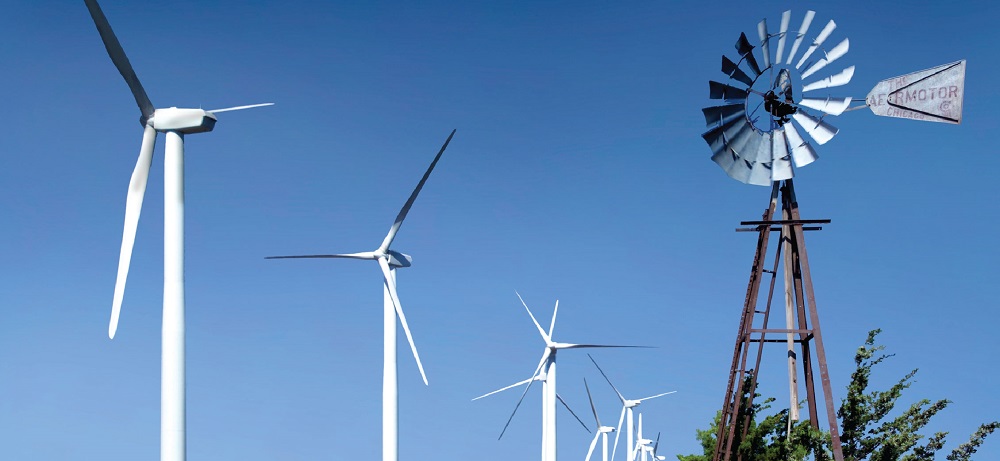Continued progression of technology is reducing the cost of wind energy. The recent success of wind to meet more than 44 percent energy demand of Denmark is not only the volume of energy wind can generate, but also the price at which it can beat conventional sources of energy. As a matter of fact, during the pre-industrial age, wind used to be the dominant source of energy to rotate wheels to power industry or sail ships. The development of technologies to extract energy from fossil fuels, starting with coal, started placing wind at the back burner. Such change offered us more reliable as well as less costly sources of energy, but at a huge cost environment. But the continued progression of technology is opening the opportunity turning wind to be less costly as well as reliable sources of energy. As reported by the World Economic Forum, according to the International Energy Agency’s (IEA) Renewables 2017 report, sharp cost reductions and improved policy support are paving the way for continued growth in the renewables sector.
Despite the recent fall of the price of natural gas, thank shale oil revolution, a large project in Europe is moving ahead to establish wind farm without the subsidy. As reported by the Financial Times, once up and running in 2022, a wind farm that will be built 22km off the Netherlands’ coast to generate 750MW of power from 90 turbines will be a major milestone of achievement of renewable energy. Moreover, already energy companies from Denmark and Germany offered to build schemes by 2024 in Germany that will rely on market prices alone. According to an Oxford-based research consultancy, subsidy-free wind energy is on the “cusp of the breakthrough” in Britain. Research of this firm predicts that onshore wind projects in the UK could be viable without subsidies by the early 2020s, while offshore wind could reach “grid parity” by the 2030s.
In one hand the volume of production of energy from the wind has been expanding, on the other hand, the price has been plummeting reaching to the record low. Turbine technology progression, being taller and bigger, has been making wind as the solution for energy to power countries, particularly having coastlines. In India, wind power tariff has plummeted to record low Rs 2.43 per kWh at a recent auction conducted in Gujarat. This record wind energy price appears to be even lower than the cost of power generated by some coal power plants. According to the media report, four power generators own the contract to supply 1500 MW together at this record low price. Such latest developments underscore growing investor interest in wind energy projects as costs of turbine generators decline, and energy harvesting efficiency keeps going up in the midst of favorable energy policy. To leverage ongoing progression of technology, India has lined up an ambitious plan to award 23GW wind power contracts by March 2020; while 100GW of the government’s targeted renewable energy capacity is to come from solar projects by 2022; 60GW is expected to be generated from wind power plants.
Even, several years ago, China was the world’s largest coal producing and consuming the country. Surprisingly, the country is cutting coal dependency now and investing steadily in wind achieving tremendous success. Although coal still makes up the largest part of China’s energy consumption, that is changing, and quicker than most have anticipated. Surprisingly in 2017, China announced plans to cancel more than 100 coal plants under development, which would have generated 120 GW electricity capacity. To offset this capacity expansion from coal, focused has shifted to renewable. To augment the solar generation capacity reaching to 112GW mark, China has been increasingly focusing on wind power. According to a report, China is on track to install at least 110.4 GW of onshore wind capacity over the next three years. Such installations would increase the country’s cumulative installed capacity by 2020 to about 264 GW, far surpassing the original target of 210 GW set during the 13th Five-Year Plan period.
Among African countries, South Africa has been leading in harvesting wind energy. According to a recent study conducted by the Council for Scientific and Industrial Research (CSIR), wind power in South Africa has come down to a price tag that is 40 percent cheaper than new coal-fired power stations. To take advantage from this attractive economics of production, only South Africa is set to produce 17.8GW electricity from renewable energy sources by 2030—with a call of soliciting bids from independent power producers to generate an initial 1.85 GW of wind energy within the next few years.
Despite having very low-cost access to coal and natural gas, the economics of energy is showing attractiveness even in the USA. According to the US energy information administration, by 2022 wind energy likely costing $157 per MWh will be slightly more costly, as low as 10 percent, than dirty coal. As a result, after the year of delays, the US offshore wind industry is finally gaining momentum, with new projects being planned along the coastlines. As it has been reported referring to experts by the Yale Scholl of Forestry & Environmental Studies publication YaleEnvironment360, “the offshore wind industry says it is aiming to soon produce electricity at a cost equal to, or lower than, coal or natural gas.”
Such achievements coupled with the continued progression of wind energy technology drives the possibility to reality for many countries of the world to be fully powered by renewable without the need of subsidy. Over the years, the wind energy industry has changed rapidly as the economics of turbine design and also tower heights have improved. The meaning of subside-free does not also mean the same in every country because regulatory frameworks differ. There is no denying that there has bee some uncertainties about the technology progression limit and the growth of alternatives. Nevertheless, the trend of advancement of technologies suggests taking calculated risks to increasingly invest in wind energy projects as a viable green alternative to conventional electrical power. Such progression is not only opening the door to have green energy in reducing pressure on the environment but also creating the opportunity for many countries to be energy self-sufficient. Despite the growth of the potentials of wind to be a source of the large volume of energy at a competitive price, many countries including Bangladesh have been largely overlooking it.
The writer is an academic, researcher and activist. He currently works as a Professor at the Department of Electrical and Computer Engineering at North South University. He can be reached at zaman.rokon.bd@gmail.com.















